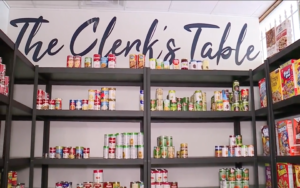Increasing access to food is a goal of many food banks these days, but few have done so as aggressively as Food Bank Singapore.
At its start ten years ago, Food Bank Singapore followed the playbook of establishing its own brick-and-mortar food pantry, as many food banks in the U.S. have recently done. But it has since pulled back from that approach. Now it is well into what it calls Food Pantry 2.0, a strategy that combines vending machines, bank cards, and partnerships with fast-food restaurant chains to make access to food as frictionless as possible.
Located in the heart of the small island nation (about the size of Rhode Island), Food Bank Singapore’s original pantry had extended hours, but still was unable to meet the needs of those having to work long hours or travel far distances. Limited food access, combined with the need to pay for rent, electricity and manpower, convinced leadership to shut the pantry down.
“Most food distribution programs take place during office hours, but hunger can strike at any time,” noted Nichol Ng, in explaining the decision. She co-founded the food bank with her brother Nicholas Ng, as a way to redirect the food waste they saw occurring within their family-owned food distribution business.
Food Bank Singapore still supplies rescued food to a network of more than 300 agencies, including schools, soup kitchens and social service agencies with registered social workers. But rather than operate its own pantry, it is turning to more modern distribution methods.
The first of these is a network of vending machines, numbering 40 so far in 14 locations. Some dispense dry, non-perishable food, while others offer frozen bento box meals that can be heated up. Food Bank Singapore hopes to expand the number of vending machines to 100, in part by encouraging corporations to sponsor them in various locations.
Low-income people access the vending-machine food using bank cards that operate like gift cards and are topped up with about $100 of value a month. Anyone can use regular bank cards to also tap the machines, a tactic that reduces any stigma around the machines and also provides an income stream to subsidize the food being distributed for free.
Low-income users get the cards from neighborhood social services organizations that are charged with assessing need. “We do not have the ability to do means testing,” noted Subaa Subramaniam, Assistant Manager at Food Bank Singapore. Instead, Food Bank Singapore supplies local social workers with, say, several dozen cards to hand out as they see fit. Recipients need to be at least 16 years old and have a valid email address so they can receive notifications about the amount left on their cards.
The cards serve another purpose. They can be used to make purchases at Subway sandwich shops and a handful of other local restaurant chains that are signed up for Food Bank Singapore’s Feed the City initiative. In all, the cards can be used at more than 100 local shops around the country. Every month, the shops send a bill to Food Bank Singapore to pay for the free meals that have been given out.
Users “get the autonomy to choose what they want to eat when they want to eat it,” Subramaniam noted.
The biggest challenge with Food Bank Singapore’s approach is meeting demand and raising enough money to meet the high cost of directly paying for meals. The vending machines get refilled once to three times a week, but consistently run out of food, Subramaniam noted.
So far Food Bank Singapore has issued about 3,000 cards. It would like to get to 10,000, which would cost it about $1 million a month or $12 million annually. “So we are just continuously fundraising,” Subramaniam said. – Chris Costanzo
Like what you’re reading?
Support Food Bank News








